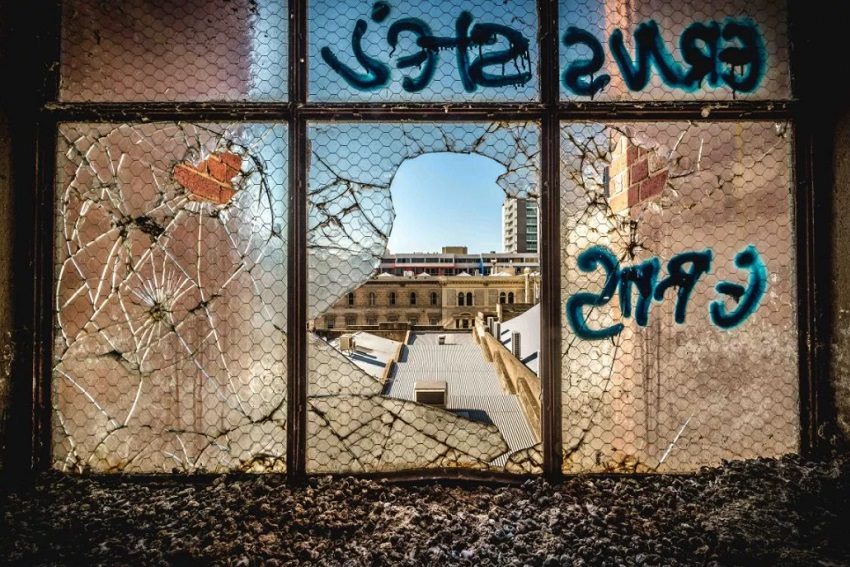How can Adelaide make use of its abandoned buildings?

With a high vacancy rate of buildings across the city, the debate about appropriate uses for empty Adelaide buildings continues.
An avid urban explorer, Holly Keeper* used to regularly explore abandoned buildings around Adelaide. Then, after one particular exploration mission, she decided to stop. As she descended upon a building she had excitedly chanced upon as deserted and ripe for investigation, she noticed a mattress set up in one corner, among other ‘signs of life’.
“Suddenly it was like I was not just having an urban adventure,” she tells The Adelaide Review. “I was invading someone’s home.”
Concerned, Keeper discussed her findings with a friend who had been homeless in the past.
“He said he and other people who were homeless would often use abandoned buildings for shelter,” she says. “He’d climb up into the roof through the manhole because it was the safest part, which is not to say it was nice in any way — it would be full of spiders and sometimes possums – it just meant that other squatters or urban explorers wouldn’t find him there.”
 Photo: Scott McCarten, Autopsy of Adelaide – Industrial Disease
Photo: Scott McCarten, Autopsy of Adelaide – Industrial Disease
Keeper is far from the only Adelaidean with a fascination for abandoned spaces around town. Scott McCarten’s ongoing project Autopsy of Adelaide — which documents derelict buildings — is extremely popular on social media, and grew from a practice of urban exploration (‘urbex’) much like Keeper’s. And, with a high vacancy rate across the city, the debate about appropriate uses for empty buildings continues.
Adelaide University PhD candidate Gillian Armstrong says that abandoned buildings in Adelaide are contested in a number of different ways. “There are those concerned with heritage and preserving heritage, and this cuts across all kinds of political spectrums and all kinds of groups in Adelaide,” Armstrong says. “There are lots of people who want to preserve a certain lifestyle and make sure no-one builds in their backyard. And then there are other people that are interested in preserving the history.”
The debate “also taps into skateboarding cultures, and people interested in decay and the politics of decay”.
 Photo: Scott McCarten, Autopsy of Adelaide – Industrial Disease
Photo: Scott McCarten, Autopsy of Adelaide – Industrial Disease
Armstrong’s PhD research is on ‘adaptive reuse’; a term that is “a bit of a buzzword at the moment”, replacing earlier concepts such as rehabilitation and re-purposing of defunct spaces. It refers to the process of reusing an old site or building for a purpose other than which it was previously built or designed for.
Hailing from Manchester, which had a developer-driven urban renaissance in the early 2000s, Armstrong is looking at debates around and barriers to adaptive reuse from the perspective of building owners and building certifiers. These are stakeholder groups who she says have not previously been asked for their opinion in research, which tends to focus on the architect’s perspective.
“I’m asking building owners why they are not pursuing adaptive reuse or, if they’ve considered it, how far along the process have they got,” Armstrong says.
Armstrong is specifically focussing on the Adelaide CBD.
“Over the last 30 years, Adelaide City Council’s made a lot of movements towards trying to find out what the problem is and trying to encourage building owners through incentives,” she says. “There are a couple of building owners in Adelaide CBD that are very proactive, and there has been some adaptive reuse going on. When I speak to people in the industry, there seems to be a different narrative for each of the abandoned buildings so it’s not one single problem.”

Photo: Scott McCarten, Autopsy of Adelaide – The Gerard & Goodman Bulding
As to why the buildings are lying empty, Armstrong says “there are a multitude of issues out there”.
“From social issues connected to family trusts, the structure of who owns the building, right down to people just being risk averse.”
Negative gearing is also an issue, Armstrong says. This policy can mean “it’s actually better for owners to let buildings sit empty, for tax purposes”.
Given the number of homeless people seeking shelter in otherwise disused buildings, could adaptive reuse help to increase the amount of safe housing in the city?
“Considering that housing shortages drive up house prices, it’s certainly economical to do adaptive reuse to residential,” Armstrong says. But there are specific issues that must be considered. “Abandoned buildings are often abandoned because they are not built to high safety standards. The space might have only one exit and be a fire trap situation. Without basic fire safety and means of escape buildings will be unsuitable for living in.”
Take Gillian Armstrong’s survey on adaptive reuse here
*name changed
Header photo: Scott McCarten, Autopsy of Adelaide – The Gerard & Goodman Bulding